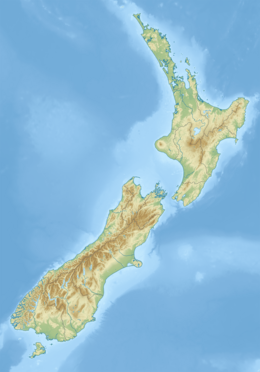| Etymology | From Māori: Motu (island) and nau (Lepidium oleraceum).[1] Plate Island has unclear origins. |
|---|---|
| Geography | |
| Location | Bay of Plenty |
| Coordinates | 37°39′43″S 176°33′36″E / 37.662°S 176.560°E |
| Area | 0.038 km2 (0.015 sq mi)[2] |
| Length | 390 m (1280 ft) |
| Width | 200 m (700 ft) |
| Administration | |
| Region | Bay of Plenty |
Motunau / Plate Island is a small island in the Bay of Plenty, roughly 12 kilometres (7.5 mi) off New Zealand's North Island at Okurei Point and a similar distance east-south-east from the much larger Mōtītī Island. The island is split into northern and southern portions by a small channel as narrow as 2 metres (6 ft 7 in) across, with several small sea stacks surrounding the two main parts of the island.[3] Like many of the other islands in the Bay of Plenty, Motunau is volcanic in origin and lacks any permanent fresh water source, and as a result has not seen permanent settlement by humans.[4]
The lack of human interaction with the island or introduced predators has led to Motunau becoming home to a range of native animal species, including a population of tuatara, as well as a breeding colony of kekeno (New Zealand fur seals) and several seabirds. As a result of this, the island was legally protected as a wildlife sanctuary in 1969,[5] and in 2021 the surrounding ocean was designated a Marine Protection Area.[6]
- ^ "Place name detail: Motunau / Plate Island". New Zealand Gazetteer. Land Information New Zealand. Retrieved 2 July 2023.
- ^ "Annex 4 – Sensitive Areas and Coastal Information" (PDF). boprc.govt.nz. Bay of Plenty Regional Council. Retrieved 2 July 2023.
- ^ Taylor, Graeme A. (1991). "Flora and Fauna of Plate (Motunau) Island, Bay of Plenty" (PDF). thebookshelf.auckland.ac.nz. Department of Conservation Te Papa Atawhai. Retrieved 2 July 2023.
- ^ Campbell, D. J.; Atkinson, I. A. E. (December 1999). "Effects of kiore ( Rattus exulans Peale) on recruitment of indigenous coastal trees on northern offshore islands of New Zealand". Journal of the Royal Society of New Zealand. 29 (4): 265–290. doi:10.1080/03014223.1999.9517597. Retrieved 2 July 2023.
- ^ "Wildlife Sanctuary (Motunau Island) Order 1969". legislation.govt.nz. Parliamentary Counsel Office. Retrieved 2 July 2023.
- ^ "Fishing, diving and spearfishing to be banned in Mōtītī Protection Area". RNZ. 9 May 2021. Retrieved 2 July 2023.

